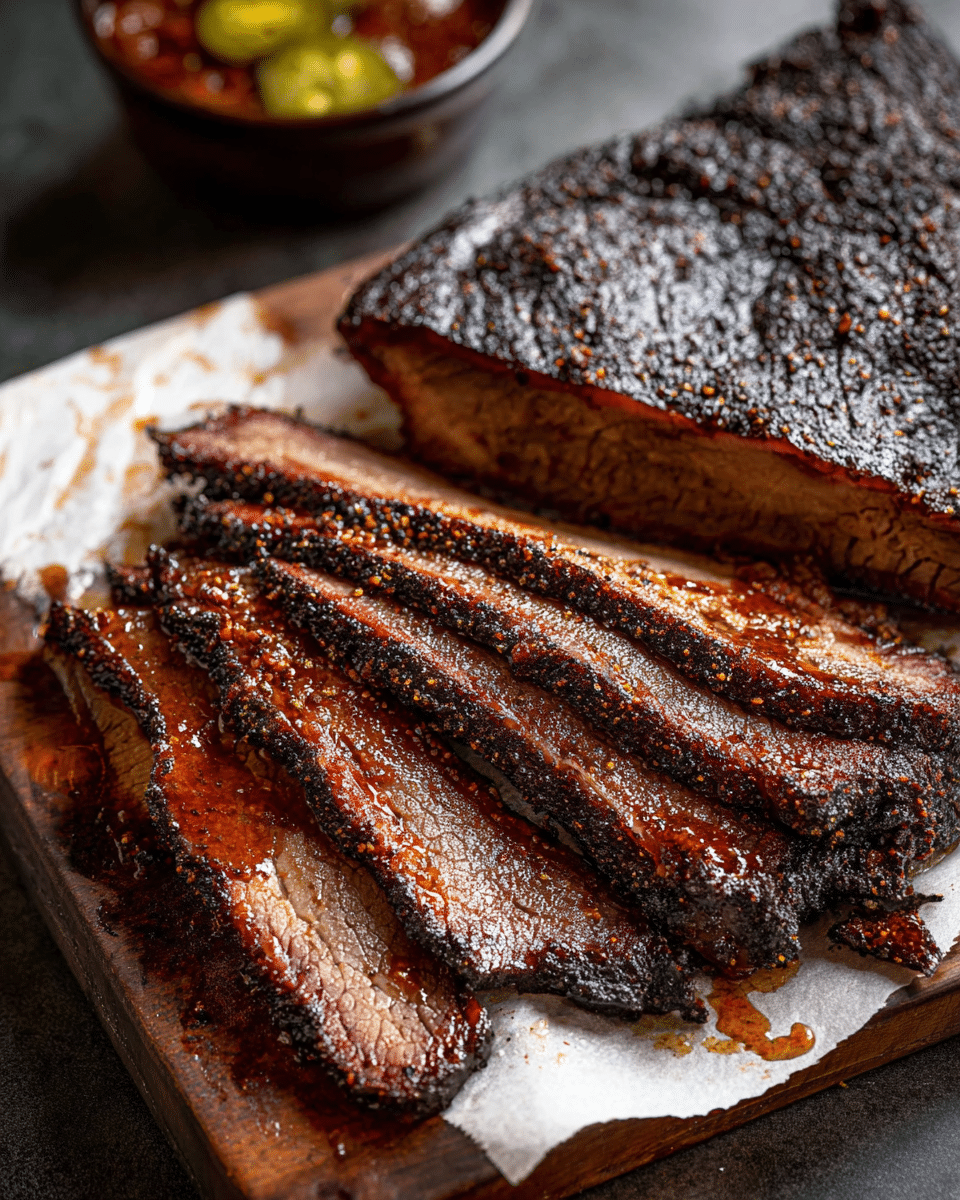This smoked brisket is a true celebration of Texas barbecue — tender, juicy, and kissed with a sweet and smoky crust thanks to the flavorful dry rub and hours of slow smoking. With minimal ingredients and maximum payoff, it’s perfect for beginners and grill masters alike.
Whether you’re cooking for a game day gathering, summer BBQ, or just because brisket sounds like a good idea (it always is), this recipe delivers on taste and texture. Plus, it pairs beautifully with all your favorite BBQ sides — from baked beans to corn on the cob.
Full Recipe:
-
1 tablespoon kosher salt
-
¼ cup brown sugar
-
1½ tablespoons smoked paprika
-
1 tablespoon onion powder
-
1 tablespoon chili powder
-
½ tablespoon garlic powder
-
1 teaspoon ground black pepper
-
4-pound brisket flat
-
Wood chips (hickory, mesquite, oak, or cherry recommended)
Directions:
-
In a small bowl, combine the salt, brown sugar, paprika, onion powder, chili powder, garlic powder, and black pepper.
-
Rub the seasoning mixture evenly over the brisket, making sure it’s fully coated.
-
Wrap the brisket in plastic wrap and refrigerate for several hours or overnight to marinate.
-
One hour before grilling, bring the brisket to room temperature and soak your wood chips in water.
-
Fill your smoker box with soaked wood chips and place it on one side of the grill. Preheat the grill to 350–375°F.
-
Reduce grill heat to 225–250°F. Place the brisket over indirect heat by turning off half of the burners and setting the meat over the unlit section.
-
Close the lid and smoke the brisket for about 4½ hours or until the internal temperature reaches 200°F.
-
Remove the brisket and let it rest for at least 45 minutes before slicing to retain juices.
Prep Time: 15 minutes | Cooking Time: 4.5 hours | Total Time: 5 hours
Kcal: 519 kcal | Servings: 6 servings
Recipe Overview
If there’s one dish that commands attention at any barbecue, it’s smoked brisket. This Texas-style delicacy isn’t just food—it’s a labor of love. Slowly smoked over wood chips until tender and infused with a bold, smoky crust, smoked brisket transforms an inexpensive cut of beef into a flavorful showstopper. It’s the kind of recipe that turns backyard cookouts into events, brings neighbors together, and has people lining up for seconds (and thirds).
Brisket’s charm lies in its balance of simplicity and depth. The ingredient list may be short—primarily just beef and spices—but the smoking technique and patient cooking process elevate it to something truly special. Whether it’s served sliced with tangy BBQ sauce, chopped for sandwiches, or plated with Southern sides, this recipe represents the very soul of American barbecue.
History and Origin
Smoked brisket traces its roots to Central Texas, where Czech and German immigrants brought their butchering traditions in the 19th century. Brisket, a tougher cut from the lower chest of the cow, was inexpensive and often overlooked—until pitmasters learned that “low and slow” smoking could transform it into something transcendent.
These early Texans used oak or mesquite wood, local to the region, to smoke meats in brick pits for hours on end. Over time, brisket became a staple of Texas BBQ joints, particularly in places like Lockhart, Austin, and Dallas. Today, it stands as the signature dish of Texas barbecue and has influenced BBQ cultures around the world.
Culturally, brisket also holds significance in Jewish cuisine, where it’s traditionally braised for holidays like Passover. The smoked variation, however, is uniquely American—rooted in the fusion of immigrant know-how and Southern ingenuity.
Variations and Adaptations
Although Texas-style brisket is the most iconic, regional interpretations abound, each with their own flair. In Kansas City, for example, brisket may be slathered with a thick, sweet tomato-based BBQ sauce. In the Carolinas, you might find it chopped and served with a vinegar-forward sauce, though pork dominates that region.
Brisket can also be prepared in a smoker, on a charcoal grill with indirect heat, or even in an oven or slow cooker when smoking isn’t feasible. Some variations involve injecting the meat with broth, beer, or apple juice for extra moisture and flavor.
The spice rub is another place where creativity flourishes. While the Texas standard uses just salt and pepper (“Dalmatian rub”), many home cooks enjoy layering in garlic powder, paprika, brown sugar, chili powder, or even coffee grounds to add complexity. Some swear by a mustard or Worcestershire sauce slather before the rub to help it adhere and build a more flavorful bark.
For a saucy twist, BBQ lovers often finish their brisket with Carolina Gold (mustard-based), Alabama White (mayonnaise-based), or classic molasses BBQ sauces. And internationally, brisket is also smoked with Asian-style rubs, or turned into fusion tacos, sandwiches, and even ramen toppings.
Nutritional Information
Smoked brisket is a high-protein, moderate-fat meat dish that can be enjoyed as part of a balanced diet. A typical 6-ounce serving of brisket contains approximately:
-
Calories: 519 kcal
-
Protein: 63 grams
-
Fat: 23 grams (8g saturated)
-
Carbohydrates: 12 grams (mostly from the dry rub’s sugar)
-
Cholesterol: 187 mg
-
Sodium: 1429 mg
-
Iron: 7 mg
-
Potassium: 1100 mg
-
Vitamin A: 1259 IU
Because brisket is a red meat, it’s rich in iron, zinc, and B vitamins—especially B12. However, it’s also relatively high in saturated fat and sodium, particularly when paired with sugary rubs or salty sauces. Choosing leaner cuts like the brisket flat, trimming the fat cap, and going easy on the sauce can make it a more heart-friendly option.
For low-carb or keto diets, smoked brisket is a superstar, especially when served without a sugary sauce. It’s also naturally gluten-free, making it accessible to those with celiac disease or gluten sensitivities.
Serving Suggestions and Pairings
Smoked brisket shines brightest when surrounded by classic BBQ accompaniments. A few favorites include:
-
Creamy coleslaw – to balance the richness of the meat with tang and crunch
-
Boston baked beans – for a touch of sweetness and fiber
-
Grilled corn on the cob – brushed with butter and smoky char
-
Macaroni and cheese – comfort food that doubles down on indulgence
-
Pickles and onions – for brightness and bite
Don’t overlook bread: thick slices of Texas toast or buttery brioche buns are perfect for serving brisket sandwiches. If you want to mix it up, pile brisket into tacos with avocado and salsa, or stir it into a smoky chili.
Drink pairings should lean toward the bold and crisp. Think IPAs, amber ales, or smoky bourbon cocktails. For non-alcoholic options, iced tea with lemon, sparkling water with lime, or a tart shrub can cleanse the palate between bites.
Tips and Tricks for Success
Perfect brisket doesn’t happen by accident—it requires a bit of technique and a lot of patience. Here are a few tips from seasoned pitmasters:
-
Choose the right cut: The brisket flat is leaner and easier to manage than the point. Look for a piece with a good fat cap to help retain moisture.
-
Season generously: Don’t be shy with your dry rub. A thick coating ensures a flavorful bark.
-
Let it rest: Resting the meat for at least 45 minutes after smoking allows juices to redistribute, making every slice succulent.
-
Monitor internal temperature: Aim for 200°F in the thickest part. Use a meat thermometer and don’t rely on time alone.
-
Use indirect heat: Smoking or grilling over indirect heat ensures slow, even cooking without drying the meat out.
-
Keep it moist: Soaking your wood chips and occasionally spritzing the brisket with apple juice or broth during cooking can help preserve moisture.
-
Skip the wrap (optional): While some wrap brisket in foil or butcher paper to accelerate the cooking (a method called the “Texas Crutch”), going unwrapped can give you a better bark—though it may take longer.
Potential Health Benefits
While brisket may not seem like a “health food,” it has a surprising number of benefits when consumed in moderation. It’s packed with high-quality protein, supporting muscle growth, repair, and satiety. The iron and zinc boost immunity and energy levels, while B vitamins play key roles in brain and metabolic health.
Advertisement
Interestingly, some studies suggest that oleic acid, a type of healthy fat found in brisket, may help reduce LDL (bad) cholesterol and raise HDL (good) cholesterol, similar to the fats found in olive oil. That said, brisket is still a red meat, so moderation is key.
When served alongside fiber-rich sides like slaw, beans, or leafy greens, smoked brisket can be part of a well-rounded, nutrient-dense meal.
Conclusion
Smoked brisket is more than just a meal—it’s a tradition, a craft, and a celebration of flavor. From its humble roots in Texas to its place at family gatherings and food festivals, it continues to bring people together around the table. Whether you’re firing up your first smoker or you’re a backyard BBQ veteran, this recipe invites you to slow down, savor the process, and enjoy every bite.
So next time you’re planning a weekend cookout or looking to impress at your next gathering, let smoked brisket be the star. With the right preparation, a bit of patience, and these helpful tips, you’ll turn a tough cut of meat into an unforgettable experience.





